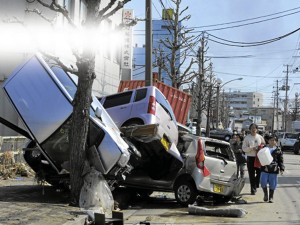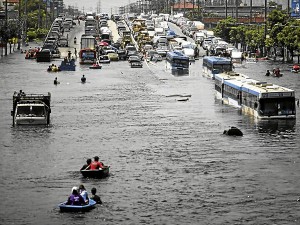The news on wheels
News does go around. And when the news items are about the cars and the industry that shakes and bakes them, you can bet you’ll get the info from all directions. Inquirer Motoring rolls out its nets to give you the best news catches in 2011, in no particular order.
1. Japan quake rocks local auto supply. A few weeks after the devastating earthquake and resulting tsunami and nuclear meltdown in northern Japan, the global automobile industry also felt the aftershocks. Inquirer Motoring soon published a few articles depicting the real picture of the Japanese automobile industry reeling from the effects of a triple calamity, and its implications on the local industry.
One such sector affected by the Japan quake is auto parts manufacturing. In April, despite assurances from Japanese automakers that their parts inventories were enough to last the next few months, then Chamber of Automotive Manufacturers of the Philippines Inc (Campi) president Elizabeth H. Lee stated alternative parts sourcing as a temporary solution.
2. Death of superbike champ Maico Buncio. The untimely demise of Buncio in an accident at Clark Speedway Racing Circuit in Angeles Pampanga in May led to a number of Inquirer Motoring stories, and raised questions on the safety of the racing circuits and the legitimacy of certain race organizers.
3. The floods in Thailand. The Inquirer business section picked up the story that the massive flooding in Thailand (a few months ago) could cause disruptions in local vehicle supplies. The full impact of the Thai floods may yet to arrive in the Philippines. According to Campi, local auto companies still had inventories. Going into the Christmas buying season, however, the work stoppage in some Thai vehicle and parts plants could cause a shortage in local vehicle supply.
On the other hand, the Thai floods were seen as an opportunity for local parts makers, as car manufacturers had been seen making the rounds of the 106 MVPMAP (Motor Vehicle Parts Manufacturers Association of the Philippines) members as early as mid-September.
Article continues after this advertisement4. An electric sports car, made in the Philippines. This October, it was announced that an all-electric grand touring car made entirely in the Philippines by Filipinos was worthy enough to be unveiled at the prestigious Specialty Equipment Market Association (SEMA) show at the Las Vegas Convention Center in Nevada from Nov. 1 to 4.
Article continues after this advertisement5. Two years on, Ondoy still in our minds. On the second anniversary of Ondoy in September, we counted the costs: Car insurance went up (according to the Philippine Insurers and Reinsurers Association, total premiums signed in for motor vehicle insurance rose to P13.5 billion in 2010). And as far as auto sales went in 2010, more and more buyers opted for the higher-clearance SUVs, AUVs, vans and pick-ups.
Succeeding killer typhoons only served to reinforce the public’s notion that a rugged country with unpredictable turns in weather does, indeed, need rugged vehicles. The devastation wrought most recently by tropical storm Sendong in Cagayan de Oro, Iligan, and other parts of southern Philippines is just the latest example.
6. Toxic taxis. In November, the spotlight fell on taxis running on liquefied petroleum gas (LPG), as a number of passengers and taxi drivers complained of respiratory distress and other health problems after reportedly riding or driving taxis fueled by LPG. A series of stories that came out exclusively in the Inquirer revealed the true causes of the air toxicity inside taxicabs, chief among them the faulty installation of LPG fuel systems, as well as poorly maintained ventilation mechanisms.
7. Unlearning the ‘wang-wang’. P-Noy’s State of the Nation address (Sona) revolved around the theme of the Wangwang (sirens) to emphasize the days of government bullying over its people have ended. It’s the sign of the times, lit in green, yellow and red, where green means go and red really means stop.
8. Longevity landmarks. 2011 was the year iconic brands celebrated a good, healthy number. On the American side, Chevrolet marked 100 years. On the German side, Mercedes Benz said hello to 125.
9. Fuel prices hit over P60/liter. Premium-branded gasoline exceeded the P60/liter, and diesel breached the critical P40/liter mark, prompting many transport groups to cry “Take a hike!”, the hike here meaning increase in transport fares. Other basic commodities such as rice, flour and sugar followed suit.
10. One resigns, two move up. For vague reasons, one of the most prominent women in the industry made a startling announcement. In June, Elizabeth Lee, then the president of the Chamber of Automotive Manufacturers of the Philippines Inc., and chief operating officer of Universal Motors Corp, resigned from both posts, prompting pundits to speculate on the real reasons she left post haste. Amid Lee’s resignation comes news of two women executives moving to the top. In February, Maricar Cristobal Parco, then ACC marketing director, was named president of Asian Carmakers Corp (exclusive distributor of BMW); and Ginia Domingo, erstwhile head of marketing at Ford Group Philippines, was named Columbian Autocar Corp’s president (CAC is the exclusive distributor of Kia Motors in the Philippines).
11. Philippines 1, Singapore 1, Brunei 1, and that’s not a football score. That’s the number of Lexus LFA units allotted by the mother company to the region. Only 500 units have ever been made (the bigger car markets such as Malaysia, Indonesia and Thailand weren’t given an LFA), each costing $430,000. Here’s another score: Philippines 1, rich Filipinos 0, because the lone LFA unit in the Philippines is not for sale.


